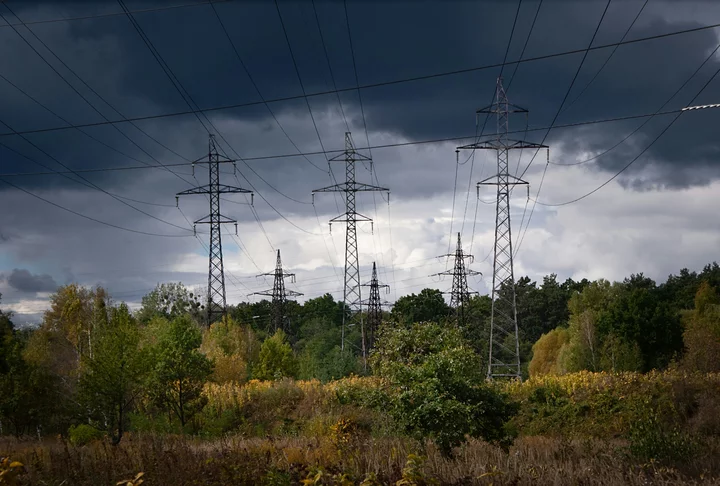Report on the Expansion of AI Data Centers and Implications for Sustainable Development Goals
The rapid proliferation of Artificial Intelligence (AI) has prompted significant investment in data center infrastructure. This report analyzes the growth of these facilities in the United States, with a specific focus on their environmental and socio-economic impacts as they relate to the United Nations Sustainable Development Goals (SDGs).
Infrastructure Development and Economic Context
Data Center Typology and Function
Data centers are facilities housing the necessary computer servers, storage, and networking equipment for digital services. The recent expansion is largely driven by the computational demands of generative AI models. Key types of data centers include:
- Hyperscale data centers: Large-scale facilities designed for massive processing workloads, crucial for cloud computing and AI.
- Enterprise data centers: Privately owned and operated facilities for a single organization’s needs.
- Colocation data centers: Facilities that rent space and resources to multiple business clients.
Geographic Distribution and Economic Drivers
The United States hosts over 4,000 data centers, with a significant concentration in Virginia, Texas, and California. State and federal governments actively encourage this development through financial incentives and expedited permitting, viewing data centers as critical for economic growth and national security. This aligns with several SDGs:
- SDG 8 (Decent Work and Economic Growth): Data centers are pursued for their potential to create construction jobs and generate local tax revenue.
- SDG 9 (Industry, Innovation, and Infrastructure): These facilities represent a fundamental component of modern digital infrastructure, essential for technological innovation and maintaining a competitive edge in the global AI race.
Energy and Environmental Impact Assessment
Analysis of Energy Consumption
The energy demand of U.S. data centers presents a significant challenge to sustainability objectives. In 2024, these facilities consumed over 4% of the nation’s total electricity, a figure projected to increase by 133% to 426 terawatt-hours (TWh) by 2030. The primary drivers of this consumption are:
- Server Operations: Approximately 60% of electricity powers the high-performance computer chips required for AI processing.
- Cooling Systems: Preventing server overheating accounts for 7% to over 30% of energy use, depending on facility efficiency.
Implications for SDG 7 (Affordable and Clean Energy)
The immense and concentrated energy demand strains local power grids and complicates the transition to sustainable energy. The current energy portfolio for U.S. data centers is misaligned with the objectives of SDG 7:
- Natural Gas: Over 40%
- Renewables (Wind and Solar): Approximately 24%
- Nuclear Power: Approximately 20%
- Coal: Approximately 15%
The continued reliance on fossil fuels, particularly natural gas, directly conflicts with the goal of increasing the share of renewable energy in the global energy mix and poses a challenge to SDG 13 (Climate Action).
Water Consumption and SDG 6 (Clean Water and Sanitation)
Cooling systems require substantial water resources. In 2023, U.S. data centers consumed an estimated 17 billion gallons of water. Projections indicate that hyperscale facilities alone could consume between 16 and 33 billion gallons annually by 2028. This level of consumption places significant pressure on local water supplies, directly challenging the sustainable management of water as outlined in SDG 6.
Socio-Economic Consequences and Public Perception
Impact on Household Electricity Costs
The expansion of data centers necessitates costly upgrades to energy infrastructure, the expense of which is often passed on to consumers. This can lead to increased electricity bills for households and small businesses, undermining principles of equity and affordability.
- In the PJM electricity market, data center growth contributed to a projected $9.3 billion price increase, potentially raising average residential bills by $16-$18 per month in some areas.
- A Carnegie Mellon University study estimates that data centers could increase the average U.S. electricity bill by 8% by 2030.
Challenges to SDG 11 (Sustainable Cities and Communities)
The strain on public utilities, risk of blackouts, and rising energy costs for residents challenge the objective of SDG 11 to make cities and human settlements inclusive, safe, resilient, and sustainable. Legislative efforts in states like Virginia and California are emerging to mandate the use of renewable energy and require usage reporting to mitigate these adverse effects.
Public Opinion on Environmental Impact
A 2024 Pew Research Center survey indicates public uncertainty regarding the long-term environmental impact of AI. Findings show a divided public:
- 25% believe AI will have a negative impact.
- 20% foresee a positive impact.
- 25% expect an equally positive and negative impact.
- 30% are unsure.
This division highlights the need for greater transparency and public discourse on balancing technological advancement with environmental stewardship and the broader Sustainable Development Goals.
Analysis of SDGs, Targets, and Indicators in the Article
1. Which SDGs are addressed or connected to the issues highlighted in the article?
-
SDG 6: Clean Water and Sanitation
The article directly addresses water consumption by data centers, highlighting the significant amount of water required for their cooling systems. This connects to the sustainable management of water resources.
-
SDG 7: Affordable and Clean Energy
A central theme of the article is the massive and growing electricity consumption of data centers. It discusses the energy mix used to power these facilities, including fossil fuels and renewables, and the strain on power grids, which relates to ensuring access to sustainable and modern energy.
-
SDG 8: Decent Work and Economic Growth
The article mentions that states are competing for data centers because they offer “construction jobs, local tax revenue and future business opportunities,” and are seen as a way to “spur local and national economic growth.” This aligns with the goal of promoting sustained, inclusive, and sustainable economic growth.
-
SDG 9: Industry, Innovation, and Infrastructure
Data centers are a critical component of modern digital infrastructure. The article focuses on their rapid expansion to support technological innovation like AI, directly relating to the development of quality, reliable, and sustainable infrastructure.
-
SDG 12: Responsible Consumption and Production
The article’s focus on the immense energy and water usage of data centers connects to the goal of ensuring sustainable consumption patterns. The projected 133% growth in electricity consumption by 2030 highlights an unsustainable trajectory of resource use.
-
SDG 13: Climate Action
The article discusses the energy sources for data centers, noting that natural gas is the primary source. The reliance on fossil fuels for such a high-growth industry has direct implications for climate change. The mention of states considering bills to require renewable energy use is a direct link to climate action policy.
2. What specific targets under those SDGs can be identified based on the article’s content?
-
SDG 6: Clean Water and Sanitation
- Target 6.4: By 2030, substantially increase water-use efficiency across all sectors and ensure sustainable withdrawals and supply of freshwater to address water scarcity. The article highlights the massive water consumption for cooling, stating that in 2023, data centers “consumed about 17 billion gallons of water” and this is projected to increase, directly relating to the need for water-use efficiency and sustainable withdrawals.
-
SDG 7: Affordable and Clean Energy
- Target 7.2: By 2030, increase substantially the share of renewable energy in the global energy mix. The article details the current energy mix for data centers, where “renewables such as wind and solar supplied about 24%,” while natural gas supplied over 40%. The discussion of states pushing for renewable energy sources directly addresses this target.
- Target 7.3: By 2030, double the global rate of improvement in energy efficiency. The article implies this target by contrasting the energy use of cooling systems in different facilities, which “ranges from about 7% at efficient hyperscalers to over 30% at less efficient enterprise facilities,” pointing to the potential for efficiency improvements.
-
SDG 8: Decent Work and Economic Growth
- Target 8.2: Achieve higher levels of economic productivity through diversification, technological upgrading and innovation, including through a focus on high-value added and labour-intensive sectors. The article frames the expansion of data centers as essential for the “global AI race” and a driver of “national economic growth” through technological innovation.
-
SDG 9: Industry, Innovation, and Infrastructure
- Target 9.4: By 2030, upgrade infrastructure and retrofit industries to make them sustainable, with increased resource-use efficiency and greater adoption of clean and environmentally sound technologies and industrial processes. The article discusses efforts to make data center infrastructure more sustainable, such as states “weighed bills requiring or incentivizing data centers to draw some of their power from renewable energy sources.”
-
SDG 12: Responsible Consumption and Production
- Target 12.2: By 2030, achieve the sustainable management and efficient use of natural resources. The article’s core data points on energy and water consumption—”183 terawatt-hours (TWh) of electricity in 2024″ projected to grow to “426 TWh” by 2030, and “17 billion gallons of water” in 2023—directly relate to the management and use of natural resources like energy and water.
3. Are there any indicators mentioned or implied in the article that can be used to measure progress towards the identified targets?
-
Total Electricity Consumption
The article provides specific figures for electricity consumption, such as “U.S. data centers consumed 183 terawatt-hours (TWh) of electricity in 2024,” and a projection that “by 2030, this figure is projected to grow by 133% to 426 TWh.” This data can serve as an indicator for Target 12.2 (efficient use of natural resources).
-
Share of Renewable Energy
The article specifies the energy mix for data centers: “Renewables such as wind and solar supplied about 24% of electricity at data centers, while nuclear power supplied around 20% and coal around 15%.” This directly measures the share of renewable energy, relevant to Target 7.2.
-
Total Water Consumption
The article quantifies water usage: “In 2023, the country’s data centers directly consumed about 17 billion gallons of water.” It also provides a projection: “Hyperscale data centers alone are expected to consume between 16 billion and 33 billion gallons of water annually by 2028.” This is a direct indicator for Target 6.4 (water-use efficiency).
-
Impact on Household Electricity Costs
The article mentions that “the average residential bill is expected to rise by $18 a month in western Maryland and $16 a month in Ohio” due to data center energy demand. This serves as a socio-economic indicator of the impact on affordable energy access for the public.
-
Energy Efficiency of Facilities
The article implies an efficiency indicator by stating that the share of energy for cooling “ranges from about 7% at efficient hyperscalers to over 30% at less efficient enterprise facilities.” This percentage can be used to measure progress toward Target 7.3 (energy efficiency).
4. Summary Table of SDGs, Targets, and Indicators
| SDGs | Targets | Indicators |
|---|---|---|
| SDG 6: Clean Water and Sanitation | 6.4: Substantially increase water-use efficiency and ensure sustainable withdrawals. | Total annual water consumption in gallons (e.g., “17 billion gallons of water” in 2023). |
| SDG 7: Affordable and Clean Energy | 7.2: Increase substantially the share of renewable energy in the energy mix. | Percentage of electricity supplied by different sources (e.g., “Renewables… supplied about 24%”). |
| SDG 7: Affordable and Clean Energy | 7.3: Double the global rate of improvement in energy efficiency. | Percentage of energy used for cooling systems as a measure of efficiency (e.g., “ranges from about 7% at efficient hyperscalers to over 30% at less efficient enterprise facilities”). |
| SDG 8: Decent Work and Economic Growth | 8.2: Achieve higher levels of economic productivity through technological upgrading and innovation. | Creation of construction jobs, local tax revenue, and business opportunities (mentioned qualitatively). |
| SDG 9: Industry, Innovation, and Infrastructure | 9.4: Upgrade infrastructure to make them sustainable with increased resource-use efficiency. | Number of states weighing bills to require or incentivize renewable energy use for data centers. |
| SDG 12: Responsible Consumption and Production | 12.2: Achieve the sustainable management and efficient use of natural resources. | Total annual electricity consumption in terawatt-hours (e.g., “183 TWh of electricity in 2024”). |
Source: pewresearch.org







